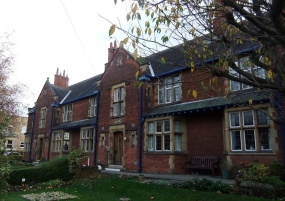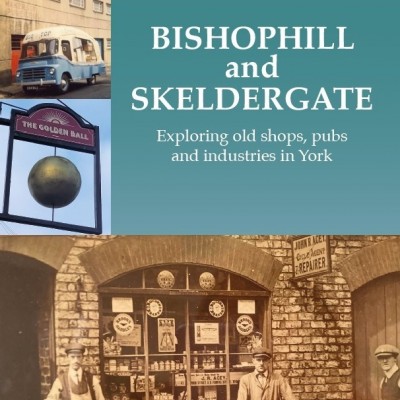27th January 2016
Housing the poor
During the course of her investigation of properties on Nunnery Lane, Pauline Alden has been looking at almhouses. Pauline writes:
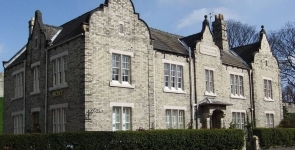 The Moat House Hotel between Victoria Bar and Nunnery Lane Car Park is an attractive old building with an interesting past. Above the door it says St. Thomas’s Hospital rebuilt 1862.
The Moat House Hotel between Victoria Bar and Nunnery Lane Car Park is an attractive old building with an interesting past. Above the door it says St. Thomas’s Hospital rebuilt 1862.
These were almshouses that accommodated 12 single women. However, the original almshouses founded before 1391 were for the maintenance of the poor and for hospitality to travellers. They were built outside Micklegate Bar. In 1478 they were transferred to the guild of Corpus Christi on condition that the Master and Brethren kept seven alms beds.
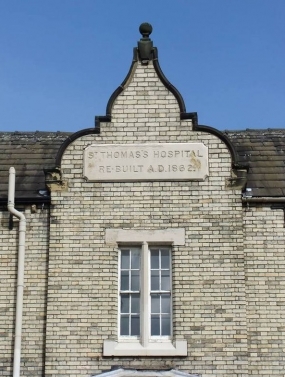 In 1546 the Charity Commissioners found that the guild kept 10 poor persons, allowing each 6s. 8d. per year, and also maintained 8 beds for poor strangers. After the transfer to the Corporation in 1553 there were reported to be ‘many poor folks and little to find them with’. From the 16th to the 19th centuries 13-18 poor folks were accommodated in the hospital, and a smaller number received pensions.
In 1546 the Charity Commissioners found that the guild kept 10 poor persons, allowing each 6s. 8d. per year, and also maintained 8 beds for poor strangers. After the transfer to the Corporation in 1553 there were reported to be ‘many poor folks and little to find them with’. From the 16th to the 19th centuries 13-18 poor folks were accommodated in the hospital, and a smaller number received pensions.

This is a lithograph by William Monkhouse from about 1845. To the right of the bar is the old St. Thomas’s Hospital. On the extreme left of the picture the timbered structure is Barstow’s Hospital.
 The old two-story stone building appears to have continued in use until the 19th century, and in 1820 it contained 12 apartments, occupied by the same number of poor widows, appointed by the Lord Mayor. The hospital was administered from 1837 by the York Charity Trustees. In 1860 the conditions of the building were reported as ‘low, damp, the lower rooms especially, ill-ventilated and dark, with brick floors’. Three years later it was replaced by the new building. Accommodation was provided for 12 women, and in 1906 the 11 inmates shared stipends totalling £80. It was closed down c 1972 and converted into the Moat Hotel.
The old two-story stone building appears to have continued in use until the 19th century, and in 1820 it contained 12 apartments, occupied by the same number of poor widows, appointed by the Lord Mayor. The hospital was administered from 1837 by the York Charity Trustees. In 1860 the conditions of the building were reported as ‘low, damp, the lower rooms especially, ill-ventilated and dark, with brick floors’. Three years later it was replaced by the new building. Accommodation was provided for 12 women, and in 1906 the 11 inmates shared stipends totalling £80. It was closed down c 1972 and converted into the Moat Hotel.
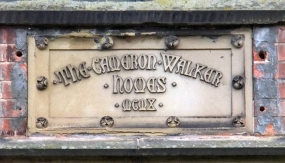 Built in 1912, the Charles Cameron Walker Homes in Bishopthorpe Road were the first almshouses to be opened in the 20th century. They comprised twelve three-room apartments in a two storied building. At foundation the Charity was endowed with £6,250 stock, producing £344 annually in 1932. By a Chancery scheme of 1912 the homes were declared open to the poor of either sex living within 10 miles of York, but in 1946 there were 10 women residents and only two couples, the old and the current caretakers. The inmates’ stipends were fixed in 1912 at 5s. per week for single people, and 8s. for married couples. In 1946, 5s. 6d. per week was being paid.
Built in 1912, the Charles Cameron Walker Homes in Bishopthorpe Road were the first almshouses to be opened in the 20th century. They comprised twelve three-room apartments in a two storied building. At foundation the Charity was endowed with £6,250 stock, producing £344 annually in 1932. By a Chancery scheme of 1912 the homes were declared open to the poor of either sex living within 10 miles of York, but in 1946 there were 10 women residents and only two couples, the old and the current caretakers. The inmates’ stipends were fixed in 1912 at 5s. per week for single people, and 8s. for married couples. In 1946, 5s. 6d. per week was being paid.
